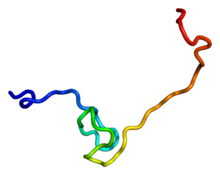- Mdm4
-
Mdm4, transformed 3T3 cell double minute 4, p53 binding protein (mouse) 
Estructura tridimensional de la proteína Mdm4.HUGO 6974 Símbolo Mdm4 Símbolos alt. DKFZp781B1423; MDMX; MGC132766; MRP1 Datos genéticos Locus Cr. 1 q32.1 Bases de datos Entrez 4194 OMIM 602704 PDB 2cr8 RefSeq NP_002384 UniProt O15151 La proteína Mdm4 (de sus siglas en inglés "murine doble minute 4") es un regulador codificado en humanos por el gen mdm4.[1] [2]
El gen humano mdm4, que juega un importante papel en procesos de apoptosis, codifica una proteína de 490 aminoácidos que contiene un dominio de dedos RING y una posible señal de localización nuclear. Esta posible señal de localización nuclear, que la poseen todas las proteínas Mdm, se encuentra localizada en el extremo C-terminal de la proteína. El ARNm de este gen presenta altos niveles de expresión en el timo y bajos niveles en todos los demás tejidos estudiados. La proteína Mdm4 producida mediante traducción in vitro ha demostrado interaccionar con p53 a través de un dominio localizado en la región N-terminal de la proteína Mdm4. Mdm4 muestra una similitud estructural significativa con la proteína de unión a p53, Mdm2.[2]
Interacciones
La proteína Mdm4 ha demostrado ser capaz de interaccionar con:
Referencias
- ↑ a b Shvarts A, Bazuine M, Dekker P, Ramos YF, Steegenga WT, Merckx G, van Ham RC, van der Houven van Oordt W, van der Eb AJ, Jochemsen AG (Sep 1997). «Isolation and identification of the human homolog of a new p53-binding protein, Mdmx». Genomics 43 (1): pp. 34–42. doi:. PMID 9226370.
- ↑ a b «Entrez Gene: MDM4 Mdm4, transformed 3T3 cell double minute 4, p53 binding protein (mouse)».
- ↑ Strachan, Gordon D; Jordan-Sciutto Kelly L, Rallapalli Ravikumar, Tuan Rocky S, Hall David J (Feb. 2003). «The E2F-1 transcription factor is negatively regulated by its interaction with the MDMX protein». J. Cell. Biochem. (United States) 88 (3): pp. 557–68. doi:. ISSN 0730-2312. PMID 12532331.
- ↑ Kadakia, Madhavi; Brown Thomas L, McGorry Molly M, Berberich Steven J (Dec. 2002). «MdmX inhibits Smad transactivation». Oncogene (England) 21 (57): pp. 8776–85. doi:. ISSN 0950-9232. PMID 12483531.
- ↑ Tanimura, S; Ohtsuka S, Mitsui K, Shirouzu K, Yoshimura A, Ohtsubo M (Mar. 1999). «MDM2 interacts with MDMX through their RING finger domains». FEBS Lett. (NETHERLANDS) 447 (1): pp. 5–9. ISSN 0014-5793. PMID 10218570.
- ↑ a b Badciong, James C; Haas Arthur L (Dec. 2002). «MdmX is a RING finger ubiquitin ligase capable of synergistically enhancing Mdm2 ubiquitination». J. Biol. Chem. (United States) 277 (51): pp. 49668–75. doi:. ISSN 0021-9258. PMID 12393902.
- ↑ Linke, K; Mace P D, Smith C A, Vaux D L, Silke J, Day C L (May. 2008). «Structure of the MDM2/MDMX RING domain heterodimer reveals dimerization is required for their ubiquitylation in trans». Cell Death Differ. (England) 15 (5): pp. 841–8. doi:. ISSN 1350-9047. PMID 18219319.
Wikimedia foundation. 2010.
